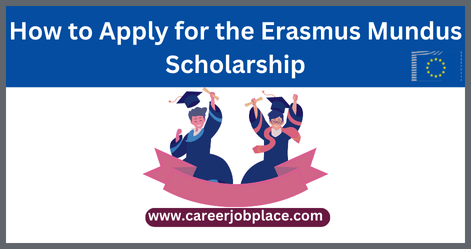Yearly, How to Apply for the Erasmus Mundus Scholarship, students from all over the world seek chances to improve their education and international experience. If that’s your goal, then the Erasmus Mundus Scholarship could just be your ticket to an extraordinary academic journey. Not just does it use financial backing, but it opens doors to diverse cultures and viewpoints. In this post, we’ll dive deep into the Erasmus Mundus Scholarship is, just how you can apply for it, and some expert suggestions to improve your opportunities of success.
Understanding the Erasmus Mundus Scholarship
Prior to diving right into the application process, it’s crucial to comprehend what this scholarship entails.
What is the Erasmus Mundus Scholarship?
The Erasmus Mundus Programme is a prominent, fully-funded scholarship that permits trainees from around the globe to pursue their master’s level in different disciplines at universities throughout Europe. The program belongs to the EU’s Erasmus+ effort aimed at cultivating worldwide collaboration and social exchange.
Benefits of the Scholarship:
- Covers tuition and participation costs.
- Provides a monthly stipend for living expenses.
- Includes travel allowances and installation costs.
- Offers comprehensive insurance coverage.
Who Can Apply?
The scholarship is open to students of any nationality with a bachelor’s degree or equivalent. Each master’s program may have specific eligibility criteria, such as language proficiency or relevant academic background. It’s essential to review these requirements carefully on the official Erasmus Mundus website.
Preparing Your Application
Gathering and preparing the right documents is a critical step. It might seem overwhelming, but breaking it down into smaller steps can help streamline the process.
#Step 1: Choose Your Program
Start by researching the various Erasmus Mundus Joint Master Degrees (EMJMD) available. Each program partners with multiple universities, offering you a unique chance to study in different countries.
- Look for programs that align with your career goals and academic background.
- Evaluate the curriculum, university rankings, and potential career pathways.
- Pro Tip: Reach out to alumni from the program to gain insights into their experiences.
#Step 2: Craft a Compelling Motivation Letter
Your motivation letter is your chance to sell yourself. Clearly convey your passion, career aspirations, and reasons for choosing the specific program. Here are some pointers:
- Connect Personal Experiences: Relate personal stories or experiences that influenced your academic and career choices.
- Be Specific: Clearly explain why the chosen program is perfect for you. Avoid generic statements.
- Ask for Feedback: Have someone review your letter to ensure it’s engaging and error-free.
- “Think of your motivation letter as a conversation starter—a way to build a relationship with the admissions jury before even meeting them.”
#Step 3: Assemble Supporting Documents
Most applications will require the following:
- Copy of your passport
- Academic transcripts and diploma
- Proof of English proficiency (such as IELTS or TOEFL)
- Letters of recommendation
- Curriculum Vitae (CV) following the Europass format
Ensuring each document is up-to-date and accurately reflects your capabilities is key.
The Application Process
#Step 4: Submit Your Application
Carefully follow submission guidelines, as each program may have different procedures. Submitting early can help avoid last-minute technical issues.
- Tailor your applications to each program’s requirements.
- Double-check that all documents are included and formatted correctly.
#Step 5: Prepare for Interviews
If shortlisted, you may be invited for an interview. This is your chance to shine and demonstrate your passion and commitment.
- Research common interview questions and practice your responses.
- Familiarize yourself with the program details to show enthusiasm.
- Prepare questions to ask the interviewers, demonstrating your genuine interest.
What Happens Next
While waiting for results, consider backup options and prepare for any outcome. Keep a positive mindset, knowing that you’ve put in your best effort.
- Explore other scholarships or funding opportunities.
- Continue building relevant skills or taking language courses.
Most Important Deadlines
*Deadline for scholarship and non-fee paying self-funded applicants: 18 December 2024
*Deadline for fee-paying self-funded applicants (on a first-come, first-served basis):15 July 2025
Conclusion
Applying for the Erasmus Mundus Scholarship is undoubtedly an endeavor that requires meticulous preparation and determination. Whether or not you receive the scholarship, the process itself offers significant personal growth and learning. Start early, connect with alumni, and persistently refine your application materials. Your aspirations can take you far, and the Erasmus Mundus Scholarship might just be the stepping stone to a global career.
Please Share These Jobs: How to Apply for the Erasmus Mundus Scholarship
Disclaimer Notice: Please note that careerjobplace.com serves as an informational platform for sharing available jobs worldwide. When you click on the apply button, you will be redirected to the career page of the respective job provider. We want to clarify that careerjobplace.com is not directly or indirectly involved in any stage of the recruitment process. We strongly advise against paying any fees for job applications or recruitment procedures. Stay vigilant and exercise caution throughout your job search.




